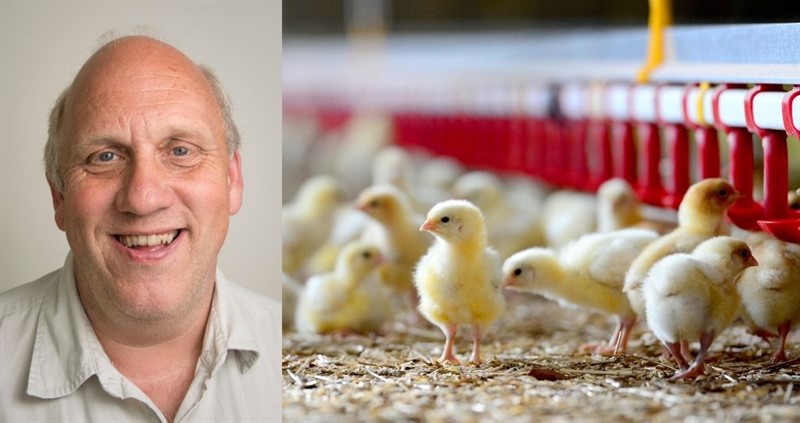Simon Barton and his wife Karen have more than 200,000 birds over two sites, producing 1.2 million standard and RSPCA Assured broilers each year.
They trialled the three most commonly used calculators, Agrecalc, the Cool Farm Tool and the Farm Carbon Calculator to test each one's functionality and ease of use, as well as how useful each was in representing a poultry farm’s emissions. This trial helped highlight areas where the calculators could be further improved for the poultry sector.
Why use a carbon calculator?
Every farm will be starting from a different point and will need its own unique action plan in order to contribute towards net zero targets. GHG calculators can be used to assess the emissions sources on farm and help inform what actions farmers and the wider industry could take in tackling climate change and working towards a net zero carbon footprint for agriculture as a whole.
What sort of data is required?
Each of the calculators asks for data to be input in different ways and some calculators ask for more detail than others. Simon spent a couple of hours gathering the data needed beforehand, which made the process of testing the calculators much easier. The following data was required:
- Total fuel and electricity use
- Number of birds
- How manure is handled
- Waste (amount recycled and amount to landfill)
- Any carbon sequestration (e.g. hedges)
- Mortality rate
- Average live weight at day old/slaughter
- Slaughter age
- Purchased bedding (type and amount)
- Water use
- Feed components
Farm Carbon Calculator
Developed by the Farm Carbon Cutting Toolkit organisation, the Farm Carbon Calculator is free to use with an unlimited amount of footprints available. It provides a carbon balance looking at emissions and sequestration.
Simon said, “It was difficult in places to understand exactly what the tool was asking for, so we had to go back and edit the information to come out with a sensible result.
“The tool allocates a carbon footprint to any buildings under 10 years old and allows you to customise the size of each shed to match what you have on farm. It also had a big range of fuels available to choose from, including biomass inputs such as wood pellets or chips that would suit many broiler farms. On the downside, the units often did not match my records, for example I buy wood chips in cubic metres and the tool asks for kilograms, which we then had to estimate.
“It also allows for carbon sequestration, so you can add any hedgerows or trees on farm. This is unlikely to be of interest to many barn-reared broiler producers, but even the small amount of hedgerow we have on farm provided a reasonable carbon sequestration figure.
“The feed inputs were not suitable for poultry as it asks for quantities of individual raw materials used per year. This had to be estimated as compound feed labels rarely display full formulations.
“Things I liked most about this calculator were that the results were really visual and quite easy to interpret and you could easily see the factors that were contributing the most to your footprint.”
Agrecalc
SAC Consulting developed this calculator and it has been endorsed by the Scottish government.
Simon said: “Agrecalc wasn’t as user friendly as the other two tools, but to me it felt the most poultry friendly. It was the only one that included options for organic and free-range production. It also allowed you to select bedding material and choose the relevant compound poultry diets from a list rather than having to work out individual raw material usage on your farm.
“The end report was a bit confusing and it wasn’t immediately clear what my overall figure was.”
Cool Farm Tool
The Cool Farm Tool provides product footprinting only, making calculations for mixed farming enterprises difficult. It is initially free for farmers. Five product footprints are available before a fee is required. Organisations that use the CFT to support sustainable agriculture pay to become members of the ‘Cool Farm Alliance’ which gives additional functionality.
Simon said: “As with the Farm Carbon Calculator, the language used was not very poultry friendly. It categorises livestock into ‘herd phases’ which don’t translate to UK poultry production. It didn’t allow for manure disposal either and assumed it was spread or stacked on farm rather than sold as an output.
“The downsides to this tool were that there was no opportunity to enter sequestration factors, and for mixed farming operations this calculator would be quite time consuming as you’d have to run it several times for each farming activity. However, for a single run through, it was quite quick to use.”
Next steps
The NFU is in continuous discussion with developers of GHG calculators to ensure that members’ voices are heard. Feedback gathered from this trial will be used to suggest ways to improve usability for poultry members, ensuring calculators are as relevant and useful to the sector as possible.
Key elements of the feedback from Simon's trial included:
- Feed sections must be relevant to poultry.
- Calculators need to be as user friendly as possible to input data quickly and easily.
- There needs to be better distinction between different production systems.
- Mortality and rejects at the slaughterhouse need to be accounted for.
Simon concluded: “None of the calculators as they stand worked particularly well for broiler chicken production, however each calculator had its own benefits. To me the Agrecalc tool felt like it was the best fit. Given that feed use is likely to be the biggest single factor in poultry’s carbon footprint, it’s important that tools reflect that accurately.”
